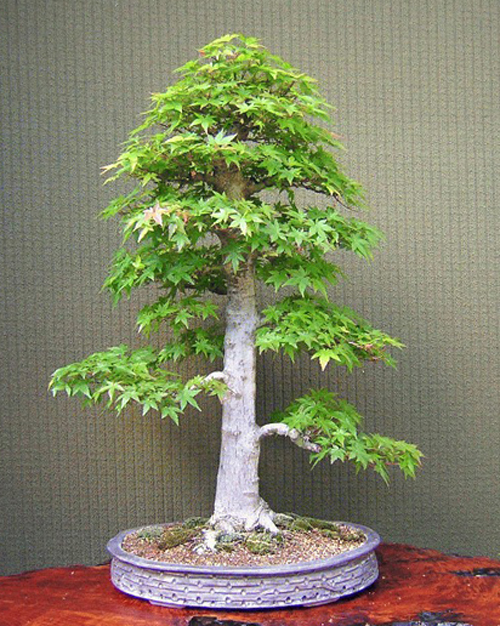
Imperfections aside, I still believe this is a remarkable bonsai. This brings us to the first question:
Why do I believe that this is a remarkable tree (you’ll have to read my mind on this one)…
…and, question two: Whose bonsai is it?
The first person who provides the correct answer to both questions will win a $25.00 gift certificate to Stone Lantern.
That tree belongs to Jay MacDonald.
Here it is in our show from this year, but in a different pot.
http://www.bssf.org/gallery2/v/BSSF+Shows/Spring+Show+2009/IMG_0730.JPG.html
He lives in Ross in Marin County, California.
I put the two photos side by side and it’s certainly the same tree, but more has changed than just the pot: The branches are long, the crown is larger and rounder; overall it has filled out quite a bit.
The feature that caught my attention and the reason for my first question (above) is more obvious in the earlier photo.
I think what caught you’re attention is the trunk from the root base to the nice taper or maybe its just me
I belive that you think this is a remarkable tree because, even though it’s not a conifer, it has been stylished as one, and the distance between branches are near “perfection”, acording to the “rules” of the japanese school. The clockwise direction of branches, and their size, it has all been done according to the “rules”.
I belive that if you look this tree from the top, you’ll see a full tree, eithout any crossing branches and stuff. The proportions of this bonsai is also a classic one, something like 6:1 (height:nebari)
Plus, you get the feeling that the tree is welcoming you (with open arms), due to the lack of branches in it’s front view, the same way black pines and other trees are stylished. Due to this lack of branches we’re able to see the “cone shape” of the trunk, also the roots spreading and the tachiagari… You don’t get distracted by it’s folliage nor branch structure, your attention is locked at the whole tree, like it always should be, like we were observing a tree in nature (even though maple trees don’t grow this way in nature).
Also, as stated above, I belive this tree belongs to Jay MacDonald.
Really nice tree :)
Vinicius,
You’ve done everything but name it.
Terry,
Yes, pretty good taper, but there is one spot near the top the is too thick. This spot is one of two reasons why I said “imperfections aside.” The other is the somewhat messy roots. Still, all in all, a very good tree.
i think this tree is succesful in that it looks like a real maple tree, parkland stlye. i think to many trees are stlyed to fit old jappanese rules. here in america modern bonsia and techniques are getting away from traditional styling. even the japanese are changing things up a bit. i feel that this Must happen in order for bonsai to live into future generations and grow as a artform. don,t get me wrong having the knowlege of ancient techniques is an important part of every succeful bonsai artists toolkit. when i look at some of the most succesful bonsai ( mabye some in the national bonsai aboretum or some of walter pall,s trees i find thta even there, there is not a strict addheranse to the rules persay.
Thanks Jonathan,
I agree about the parkland style, it does have the feeling of a majestic tree in a park somewhere. What I was looking for it that it looks very much like a formal upright style bonsai in the older photo (with the round pot), and that I couldn’t recall ever seeing a formal upright Japanese maple.
Good blog, but im having some minor problems with some images not showing. Maybe because i use Opera Browser? Well i’m bookmarking it for further reading.
Thanks. I don’t know anything about Opera. Maybe someone out there knows if there’s a simple solution.